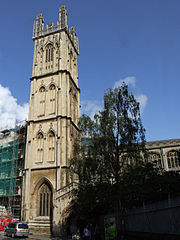I’m currently reading Charles Wells’ ‘A short history of the port of Bristol’, published in 1909 and available free of charge online from the Internet Archive.
Apart from the changes in the course of the Bristol Avon, what particularly interested me was the story of the development of the early port up until the completion of the Floating Harbour in 1809.
What intrigued me in particular was a very brief passage in Wells’ first chapter relating to the 16th century, as follows:

As the centuries passed nothing seems to have been done to further improve the facilities of the port, and many merchants were content with their own private landing-stages on the banks of the tidal Avon. There is, however, now and then a mention of repairs to the Quay in the Corporation records. In November, 1577, for example, is this entry in the audit book: “Paid the churchwardens of St Stephen’s for one tombstone for the Quay wall, 4s.”
The tombstone intrigued me: I’ve long observed that old tombstones are often used for paving on church property. However, this is the first time I’ve seen their use for other purposes off church property recorded. Was the actual tombstone new and unused? If an old one, had the family whose grave it marked long died out? If used, did it still have an inscription? How many tombstones ended up in the walls of the city docks and the paving of the quay over the centuries?
Historians of Bristol are invited to leave possible answers below.